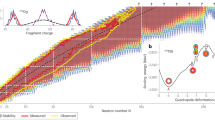Abstract
Four new elements with atomic numbers Z = 113, 115, 117 and 118 have recently been added to the periodic table. The questions pertaining to these superheavy systems are at the forefront of research in nuclear and atomic physics, and chemistry. This Perspective offers a high-level view of the field and outlines future challenges.





Similar content being viewed by others
References
Karol, P. J., Barber, R. C., Sherrill, B. M., Vardaci, E. & Yamazaki, E. Discovery of the elements with atomic numbers Z = 113, 115 and 117. Pure Appl. Chem. 88, 139–153 (2016).
Karol, P. J., Barber, R. C., Sherrill, B. M., Vardaci, E. & Yamazaki, E. Discovery of the element with atomic number Z = 118 completing the 7th row of the periodic table (IUPAC Technical Report). Pure Appl. Chem. 88, 155–160 (2016).
Münzenberg, G. & Morita, K. Synthesis of the heaviest nuclei in cold fusion reactions. Nucl. Phys. A 944, 3–4 (2015).
Oganessian, Y. T. & Utyonkov, V. K. Super-heavy element research. Rep. Prog. Phys. 78, 036301 (2015).
Düllmann, C. E. Studying chemical properties of the heaviest elements: one atom at a time. Nucl. Phys. News 27, 14–20 (2017).
Erler, J. et al. The limits of the nuclear landscape. Nature 486, 509–512 (2012).
Ćwiok, S., Dobaczewski, J., Heenen, P.-H., Magierski, P. & Nazarewicz, W. Shell structure of the superheavy elements. Nucl. Phys. A 611, 211–246 (1996).
Heenen, P.-H., Skalski, J., Staszczak, A. & Vretenar, D. Shapes and α- and β-decays of superheavy nuclei. Nucl. Phys. A 944, 415–441 (2015).
Myers, W. D. & Swiatecki, W. Nuclear masses and deformations. J. Nucl. Phys. 81, 1–60 (1966).
Magierski, P. & Heenen, P.-H. Structure of the inner crust of neutron stars: crystal lattice or disordered phase? Phys. Rev. C. 65, 045804 (2002).
Schuetrumpf, B., Nazarewicz, W. & Reinhard, P.-G. Central depression in nucleonic densities: trend analysis in the nuclear density functional theory approach. Phys. Rev. C. 96, 024306 (2017).
Ćwiok, S., Heenen, P. H. & Nazarewicz, W. Shape coexistence and triaxiality in the superheavy nuclei. Nature 433, 705–709 (2005).
Düllmann, C. E. & Block, M. Island of heavyweights. Sci. Am. 318, 46–53 (2018).
Nilsson, S. G. et al. On the nuclear structure and stability of heavy and superheavy elements. Nucl. Phys. A 131, 1–66 (1969).
Bender, M., Nazarewicz, W. & Reinhard, P.-G. Shell stabilization of super- and hyperheavy nuclei without magic gaps. Phys. Lett. B 515, 42–48 (2001).
Agbemava, S. E., Afanasjev, A. V., Nakatsukasa, T. & Ring, P. Covariant density functional theory: reexamining the structure of superheavy nuclei. Phys. Rev. C. 92, 054310 (2015).
Jerabek, P., Schuetrumpf, B., Schwerdtfeger, P. & Nazarewicz, W. Electron and nucleon localization functions of Oganesson: approaching the Thomas-Fermi limit. Phys. Rev. Lett. 120, 053001 (2018).
Möller, P., & Nix, J. R. Stability of heavy and superheavy elements. J. Phys. G 20, 1681–1747 (1994).
Tolokonnikov, S. V., Borzov, I. N., Kortelainen, M., Lutostansky, Y. S. & Saperstein, E. E. Alpha-decay energies of superheavy nuclei for the Fayans functional. Eur. Phys. J. A 53, 33 (2017).
Baran, A. et al. Fission barriers and probabilities of spontaneous fission for elements with Z ≥ 100. Nucl. Phys. A 944, 442–470 (2015).
Giuliani, S. A., Martnez-Pinedo, G. & Robledo, L. M. Fission properties of superheavy nuclei for r-process calculations. Phys. Rev. C. 97, 034323 (2018).
Poenaru, D. N., Gherghescu, R. A., Greiner, W. & Shakib, N. S. How Rare Is Cluster Decay of Superheavy Nuclei? 131–140 (Springer, Cham, 2015).
Warda, M. & Robledo, L. M. Microscopic description of cluster radioactivity in actinide nuclei. Phys. Rev. C. 84, 044608 (2011).
Schwerdtfeger, P., Pašteka, L. F., Punnett, A. & Bowman, P. O. Relativistic and quantum electrodynamic effects in superheavy elements. Nucl. Phys. A 944, 551–577 (2015).
Schwerdtfeger, P. Toward an accurate description of solid-state properties of superheavy elements: A case study for the element Og (Z = 118). EPJ Web Conf. 131, 07004 (2016).
Eliav, E., Fritzsche, S., & Kaldor, U. Electronic structure theory of the superheavy elements. Nucl. Phys. A 944, 518–550 (2015).
Pyykkö, P. A suggested periodic table up to Z ≤ 172, based on Dirac–Fock calculations on atoms and ions. Phys. Chem. Chem. Phys. 13, 161–168 (2011).
Wapstra, A. H. et al. Criteria that must be satisfied for the discovery of a new chemical element to be recognized. Pure Appl. Chem. 63, 879–886 (1991).
Korschinek, G., & Kutschera, W. Mass spectrometric searches for superheavy elements in terrestrial matter. Nucl. Phys. A 944, 190–203 (2015).
Ter-Akopian, G., & Dmitriev, S. Searches for superheavy elements in nature: cosmic-ray nuclei; spontaneous fission. Nucl. Phys. A 944, 177–189 (2015).
Goriely, S. & Pinedo, G. M. The production of transuranium elements by the r-process nucleosynthesis. Nucl. Phys. A 944, 158–176 (2015).
Ackermann, D. & Theisen, C. Nuclear structure features of very heavy and superheavy nuclei—tracing quantum mechanics towards the ‘island of stability’. Phys. Scr. 92, 083002 (2017).
Zagrebaev, V., & Greiner, W. Cross sections for the production of superheavy nuclei. Nucl. Phys. A 944, 257–307 (2015).
Itkis, M., Vardaci, E., Itkis, I., Knyazheva, G., & Kozulin, E. Fusion and fission of heavy and superheavy nuclei (experiment). Nucl. Phys. A 944, 204–237 (2015).
Loveland, W. Synthesis of transactinide nuclei using radioactive beams. Phys. Rev. C. 76, 014612 (2007).
Lee, M. S. Elemental haiku. Science 357, 461–463 (2017).
Dmitriev, S., Itkis, M. & Oganessian, Y. Status and perspectives of the Dubna superheavy element factory. EPJ Web Conf. 131, 08001 (2016).
Acknowledgements
Discussions with Y. Oganessian and P. Schwerdtfeger, and useful comments from D. Lee are gratefully appreciated. This work was supported by the US Department of Energy under award numbers DOE-DE-NA0002847 (NNSA, the Stewardship Science Academic Alliances programme), DE-SC0013365 (Office of Science) and DE-SC0018083 (Office of Science, NUCLEI SciDAC-4 collaboration).
Author information
Authors and Affiliations
Corresponding author
Ethics declarations
Competing interests
The author declares no competing interests.
Additional information
Publisher’s note: Springer Nature remains neutral with regard to jurisdictional claims in published maps and institutional affiliations.
Rights and permissions
About this article
Cite this article
Nazarewicz, W. The limits of nuclear mass and charge. Nature Phys 14, 537–541 (2018). https://doi.org/10.1038/s41567-018-0163-3
Received:
Accepted:
Published:
Issue Date:
DOI: https://doi.org/10.1038/s41567-018-0163-3
- Springer Nature Limited
This article is cited by
-
The quest for superheavy elements and the limit of the periodic table
Nature Reviews Physics (2023)
-
Random forest-based prediction of decay modes and half-lives of superheavy nuclei
Nuclear Science and Techniques (2023)
-
On the time-scale of quasifission and Coulomb fission
Pramana (2022)
-
Upper Limit of the Periodic Table and the Future Superheavy Elements
Resonance (2021)
-
Cluster radioactivity in 294,296Og
Hyperfine Interactions (2021)





